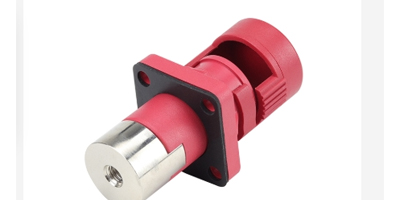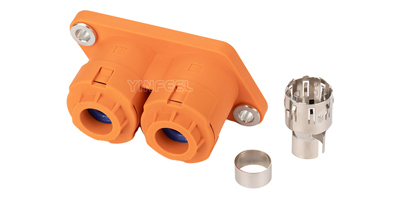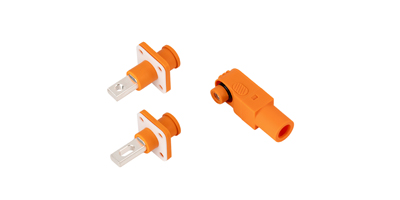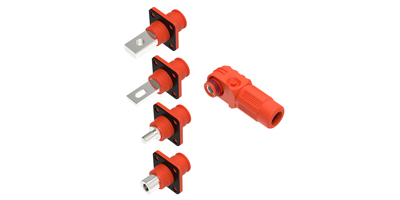Energy battery storage connectors, as crucial components in energy storage systems, have their performance and quality directly related to the safety, reliability and efficiency of the entire energy storage system. The formulation of industry standards plays a vital role in regulating the design, production, testing and application of connectors, helping to ensure the compatibility and interchangeability among products of different enterprises and promoting the healthy and orderly development of the energy battery storage industry.

Electrical Performance Standards
Rated Voltage and Current
Clearly define the rated voltage range of energy battery storage connectors. For example, there are commonly different levels such as 500V, 1000V or even higher like 1500V to meet the needs of energy storage systems of different scales.
Meanwhile, determine the rated current values, which range from tens of amperes to hundreds of amperes, such as 100A, 200A, 350A, etc., depending on the application scenarios of the connectors and the power requirements of the connected equipment. During the production process, enterprises must ensure that the connectors can operate stably under the rated voltage and current conditions without electrical failures such as overheating, sparking or breakdown.
Contact Resistance
Set a strict upper limit for the contact resistance of connectors. Generally speaking, the contact resistance of high-quality energy battery storage connectors should be as low as possible, usually at the milliohm level, such as no more than 10 milliohms or even lower.
Low contact resistance can reduce the power loss during the transmission process and improve the overall efficiency of the energy storage system. In the product testing process, professional resistance measuring instruments should be used to accurately measure the contact resistance to ensure that it meets the standard requirements.
Insulation Resistance
Require connectors to have sufficiently high insulation resistance to prevent leakage and short-circuit phenomena. The standards will stipulate that under specific voltage conditions, such as 1000V DC or 1500V DC, the insulation resistance should reach a certain value, for example, not less than 1000 megohms.
The insulation resistance is usually measured between different electrodes of the connector and between the electrodes and the outer shell using an insulation resistance tester. Only products that meet the standards can enter the market circulation.
Mechanical Performance Standards
Insertion and Withdrawal Forces
Regulate the range of insertion and withdrawal forces of connectors. The insertion force should not be too large to avoid difficulties for operators during installation or damage to connected equipment. Generally, the insertion force is between a few newtons and dozens of newtons.
The withdrawal force also needs to be controlled within a reasonable range to ensure that it can be easily pulled out when disconnection is required, while not being too small to cause loose connections. For example, the insertion force may be specified not to exceed 50N, and the withdrawal force not to be less than 10N and not to exceed 30N, etc., depending on the type and size of the connectors.
Mechanical Strength
Connectors should have sufficient mechanical strength to withstand certain tensile, compressive and torsional forces. For example, under the action of a certain axial tensile force, such as 500N or 1000N, the connectors should not break, deform or have loose connections.
For energy storage connectors that need to work in a vibrating environment, vibration tests are also required to simulate the actual vibration frequencies and amplitudes in the working process and ensure that the connectors can maintain good connection performance and mechanical integrity under vibrating conditions.
Durability
Establish the standard for the insertion and withdrawal durability of connectors, that is, stipulate the number of insertion and withdrawal operations that the connectors can withstand. Generally, connectors are required to withstand thousands or even tens of thousands of insertion and withdrawal operations, such as 5000 times or 10000 times, etc.
Their electrical and mechanical performances should still meet the standard requirements after completing the specified number of insertion and withdrawal operations. This requires optimization in aspects such as material selection, structural design and manufacturing processes to improve the durability of connectors.
Environmental Adaptability Standards
Temperature Range
Determine the temperature range in which energy battery storage connectors can work normally. Generally, it includes the low-temperature limit and the high-temperature limit, such as from -40°C to 85°C or a wider temperature interval.
In a low-temperature environment, the materials of the connectors should not become brittle and the connection performance should not be affected. In a high-temperature environment, they should be able to withstand the long-term effect of high temperature without softening, deforming or having a decline in electrical performance. Temperature cycle tests are carried out on the connectors using high and low temperature test chambers to verify their performance stability under different temperature conditions.
Protection Level
Stipulate the protection level of connectors, such as the common IP65, IP67, etc. The IP65 protection level requires the ability to prevent dust from entering and a certain degree of protection against water spray.
IP67 requires that it can still work normally when immersed in water for a short time. The protection level tests include dustproof tests and waterproof tests. Special testing equipment and methods are used to simulate different environmental conditions to ensure that the protection performance of connectors meets the standard requirements and can adapt to the use in harsh environments such as outdoors and in wet conditions.
Corrosion Resistance
Since energy battery storage connectors may work in an environment containing corrosive substances such as acids and alkalis, the standards will require their corrosion resistance.
Usually, a salt spray test is used to test the corrosion resistance of connectors. After a certain period of time, such as 48 hours or 96 hours of continuous spraying with a 5% salt spray concentration, the surface of the connectors should not have severe corrosion phenomena such as rusting or plating peeling, and their electrical and mechanical performances should also remain basically unchanged.
Safety and Reliability Standards
Anti-misinsertion Design
Require connectors to have an effective anti-misinsertion structure or identification. For example, through different shapes, sizes, color coding or mechanical structures, etc., the positive and negative connectors or connectors with different functions cannot be inserted incorrectly to avoid short-circuit, fire and other safety accidents caused by misinsertion.
In the product design stage, full consideration should be given to the anti-misinsertion design, and specific anti-misinsertion requirements and testing methods should be clearly defined in the standards.
Fire Resistance
Regulate the fire resistance standard of connectors. Generally, connectors are required to be made of flame-retardant materials for the outer shell and internal insulating parts.
Through combustion tests, such as the UL94 combustion test standard, determine the flame-retardant grade of the connector materials, such as V-0, V-1 or V-2, etc., to ensure that in the event of an electrical fault or fire, the connectors can prevent the spread of flames within a certain period of time and reduce the losses and hazards caused by the fire.
Reliability Testing Methods and Requirements
Establish a series of reliability testing methods and standard requirements. In addition to the electrical, mechanical and environmental tests mentioned above, it also includes tests such as damp heat tests and shock tests.
The damp heat test is used to simulate the impact of a high-temperature and high-humidity environment on connectors, and the shock test is used to examine the reliability of connectors when subjected to sudden external shocks. Through these comprehensive reliability tests, it is ensured that energy battery storage connectors can work stably and reliably throughout their service life cycle and ensure the safe operation of energy storage systems.






